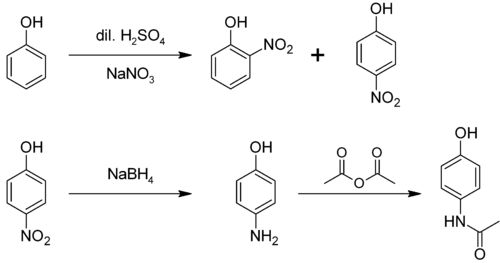4-Aminophenol
| |||
| Names | |||
|---|---|---|---|
| Preferred IUPAC name
4-Aminophenol[1] | |||
Other names
| |||
| Identifiers | |||
3D model (
JSmol ) |
|||
| 385836 | |||
| ChEBI | |||
| ChEMBL | |||
| ChemSpider | |||
ECHA InfoCard
|
100.004.198 | ||
| EC Number |
| ||
| 2926 | |||
| KEGG | |||
| MeSH | Aminophenols | ||
PubChem CID
|
|||
| UNII | |||
| UN number | 2512 | ||
CompTox Dashboard (EPA)
|
|||
| |||
| |||
| Properties | |||
| C6H7NO | |||
| Molar mass | 109.128 g·mol−1 | ||
| Appearance | Colorless to reddish-yellow crystals | ||
| Density | 1.13 g/cm3 | ||
| Melting point | 187.5 °C (369.5 °F; 460.6 K) | ||
| Boiling point | 284 °C (543 °F; 557 K) | ||
| 1.5 g/100 mL | |||
| Solubility |
| ||
| log P | 0.04 | ||
| Acidity (pKa) |
| ||
| Structure | |||
| orthorhombic | |||
| Thermochemistry | |||
Std enthalpy of (ΔfH⦵298)formation |
-190.6 kJ/mol | ||
| Hazards | |||
| GHS labelling: | |||
  
| |||
| Warning | |||
| H302, H332, H341, H410 | |||
| P201, P202, P261, P264, P270, P271, P273, P281, P301+P312, P304+P312, P304+P340, P308+P313, P312, P330, P391, P405, P501 | |||
| NFPA 704 (fire diamond) | |||
| Flash point | 195 °C (383 °F; 468 K) (cc) | ||
| Lethal dose or concentration (LD, LC): | |||
LD50 (median dose)
|
671 mg/kg | ||
| Related compounds | |||
Related aminophenols
|
2-Aminophenol 3-Aminophenol | ||
Related compounds
|
Aniline Phenol | ||
Except where otherwise noted, data are given for materials in their standard state (at 25 °C [77 °F], 100 kPa).
| |||
4-Aminophenol (or para-aminophenol or p-aminophenol) is an
Reflecting its slightly hydrophilic character, the white powder is moderately soluble in alcohols and can be
The compound is one of three
Preparation
From phenol
It is produced from phenol by nitration followed by reduction with iron. Alternatively, the partial hydrogenation of nitrobenzene affords phenylhydroxylamine, which rearranges primarily to 4-aminophenol (Bamberger rearrangement).[4]
- C6H5NO2 + 2 H2 → C6H5NHOH + H2O
- C6H5NHOH → HOC6H4NH2
From nitrobenzene
It can be produced from nitrobenzene by electrolytic conversion to phenylhydroxylamine, which spontaneously rearranges to 4-aminophenol.[5]
From 4-nitrophenol
4-nitrophenol can be reduced through a variety of methods, to yield 4-aminophenol. One method involves hydrogenation over a Raney Nickel catalyst. A second method involves selective reduction of the nitro group by Tin(II) Chloride in anhydrous ethanol or ethyl ethanoate. [6][7]
Uses
4-Aminophenol is a building block used in organic chemistry. Prominently, it is the final intermediate in the industrial synthesis of paracetamol. Treating 4-aminophenol with acetic anhydride gives paracetamol:[8][9][10]
It is a precursor to amodiaquine, mesalazine, AM404, parapropamol, B-86810 & B-87836 (c.f. WO 2001042204).
4-Aminophenol converts readily to the
References
- ISBN 978-0-85404-182-4.
- ISBN 978-1498754286.
- ^ CRC Handbook of Chemistry and Physics 65th Ed.
- S2CID 54499902
- ^ US2998450A, Godfrey, Wilbert & De, Angelis John, "Process of preparing nu-acetyl-p-amino phenol", issued 1961-08-29
- ISSN 0040-4039.
- ISBN 0-85404-375-6.
- ISBN 978-0-470-87171-3.
- ISBN 978-3527306732.
- .




